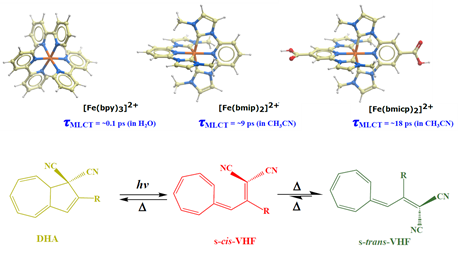The global demand for energy is rising and for a longtime solar energy has been considered as one of the best renewable and clean alternatives to unsustainable energy sources. One of the big challenges in using solar energy is to make its conversion and storage cheap, which is of particular importance in large-scale production of solar cells. This requires finding low-cost, earth-abundant,and environmentally friendly materials. In this regard,theoretical chemistry methods by providing a deeperknowledge and understanding play an important role as a complementary tool alongside experimental techniques and in development of new and high efficient materials.
This PhD thesis targets theoretical investigations on transition metal complexes and photoswitchable organic molecules, two classes of materials relevant for solar energy conversion and storage, using a wide range oftheoretical approaches. The main results of this project are atomistic insights into the mechanisms behind a variety of light energy conversion processes.
A deep understanding of the photorelaxation processes occurring upon light absorption would be necessary for designing and developing more efficient materials. Quantum description of the photorelaxation dynamics in the presence of solvent is not feasible due to an exponential growth of computational time with the increase of nuclear degrees of freedom. On the other hand, it has been evidenced that the solvent can alter the dynamics of the solute molecule significantly.
The thesis provides a reliable scheme for describing solvent structural dynamics using MD simulations and shows that implicit the polarizable continuum model (PCM) can provide a trade-off between accuracy and computational cost for accounting for the solvent effects on the solute intramolecular relaxation processes.This opens for the possibility of using these solvation approaches in quantum dynamics simulations of photorelaxation processes.

The molecular structures of Fe(II) polypyridine derivatives and their MLCT lifetimes in H2O and CH3CN solutions.